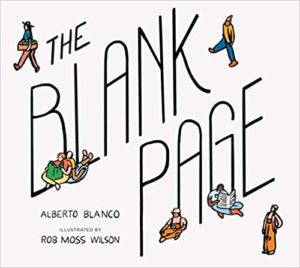This month’s PB review is by Ryan G. Van Cleave (Semi-Professional Insider at Only Picture Books) and Ringling College of Art and Design Illustration Professor (and OPB pal) David C. Gardner.
–Ryan’s Review of the Writing–
The story is quiet, calm, and simple. People who were once outside are now inside. And it’s not just people in one or two places who go inside–it’s “Everyone. Everywhere. All over the world.” But she adds, “Well, almost everyone. Some people needed to be…where they needed to be.”
Who are these people who are exempt from heading indoors? The art that tells us–it’s people from hospitals, police stations, and fire departments. And they’re all wearing face masks.
While the words “virus,” “pandemic,” and “COVID” aren’t included anywhere, that’s clearly what this book is addressing–it’s a fine example of an “of the moment” book. Pham captures the worldwide scope of the coronavirus situation via artwork showing people of all types, and the constant use of “We.” She does an admirable job of presenting both the private and public experiences of a world facing the challenges of a pandemic.
The art style seems to create some of the tension many of us have felt over the past year. I think it has to do with the textures and colors, but I’ll leave it to David to dig deeper into that aspect of things. Since Pham admits that she never thinks of the words first, I suspect there’s a rich trove of details to examine in the art that launched this book.
Regardless, it’s very hard to create a picture book that deals with such a topical issue, but Pham dodges both sentimentality and didacticism with the only attempt at nudging people toward specific action being in this spread below, near the end of the book.
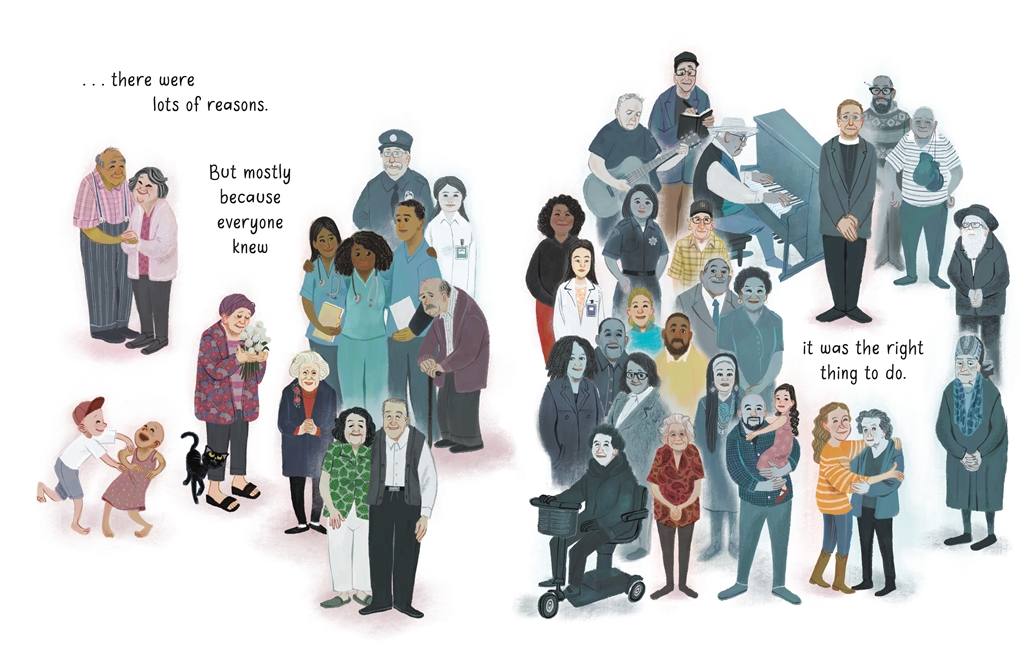
Outside, Inside ends on an appropriate, uplifting note: “And we remembered that soon spring would come. Inside…and outside.” Utilizing the metaphorical versus the literal here is a wise choice that helps open up the book and make it feel bigger than other “of the moment” texts.
This book is a welcome, timely response to a crisis that has dominated our world for a year and requires vital, careful conversations with the children in our lives going forward. Well done, LeUyen Pham.
4.75 out of 5 pencils
–David’s Review of the Illustrations–
LeUyen Pham’s evocative cover sets the tone: a girl and her pet black cat, seen from behind, looking through a window. Outside, only white. It’s a playful and mysterious image – I couldn’t help wondering what was out there.
The book starts with a bustling neighborhood street, full of people. In the next spread, the same street is empty.
Something strange is going on.
Even without the words, we can see that. When the people disappear inside, they seem to take the bright colors with them. The palette becomes muted.
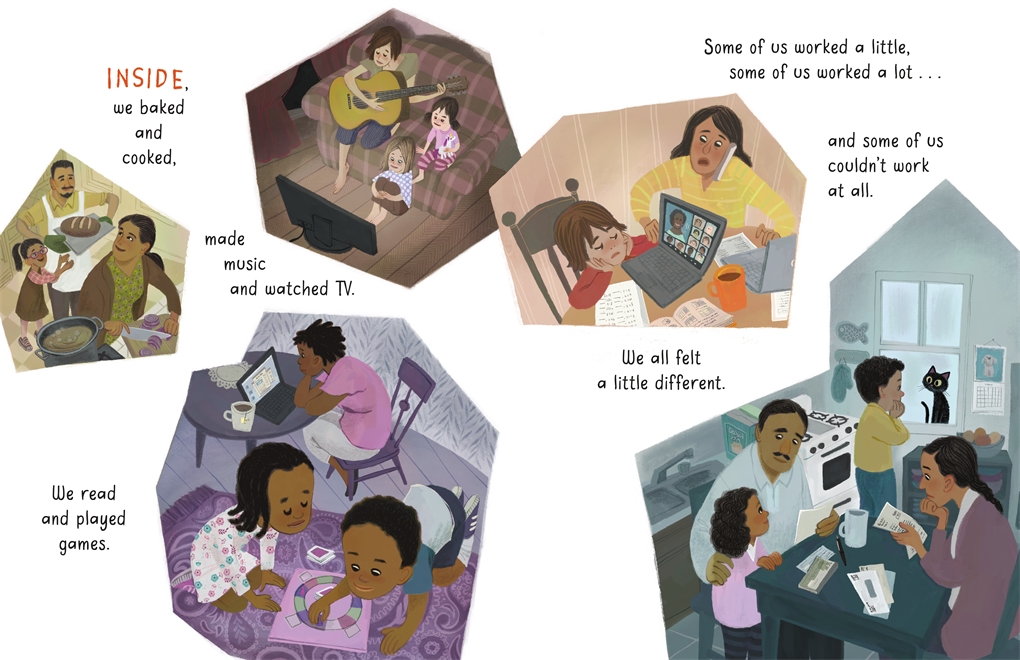
The book, we realize, is a visual journal, showing empty shops and everyday people grounded in everyday details: laptops, masks, indoor activities. And hopeful moments, too: a teddy bear in a window, a family happily baking bread, a drive-by birthday party.
Double spreads are interspersed with vignettes, illustrated scenes like snapshots, images that are common to us all now: Kids playing board games, attending online classes, parents worrying over bills to pay.
The artist has said that she based the pictures on daily drawings she made, recording the pandemic for herself, sketching moments from each day.
An especially effective spread is a mosaic of these vignettes centered around a hospital. In one image, an exhausted health care worker naps on a breakroom couch while another calls home.
We see other cartoon photos of exhausted nurses and doctors, patients on gurneys, and families, all types, huddled in concern and support.
At some point, the artist opens the story up to include the world. Early in her career, Ms. Pham worked as a layout artist for Dreamworks Animation, and her attention to environment and regional architectural details is quite effective. She tells us in pictures: This situation is global.
Still, she uses a light touch. The world never seems too big or overwhelming. In a brilliant, subtle bit of visual storytelling, the girl and her cat act as our tour guides. The bold, simple shapes reminded me of the lighthearted, gouache-painted Golden Book illustrations of Disney great Mary Blair. There are plenty of vibrant colors to appeal to a child, but she balances them with grayed tones that keep the story grounded in our shared, often challenging, reality.
In the end, the artist’s overall tone is one of hopefulness.
She visualizes this with plants, outside and inside. Growing things: A potted plant leafing out as the book progresses, trees that bud and bloom.
One especially effective passage near the book’s end suggests that we are all the same inside. Reaching a colorful crescendo, the flood of hearts could seem cliché as a visual symbol, but in this artist’s hands, the valentines become a lovely, moving design, a powerful extension of the text.
Ms. Pham captures the pandemic and the lockdown with a reporter’s eye and an artist’s big spirit. Whimsical and heart-tugging, the illustrations strike the perfect tone for a children’s book. This is a much-needed report from the trenches, and each page-turn offers a perspective that is sure to comfort children – and their grown-ups.
It certainly comforted me.
5 out of 5 crayons
 David C. Gardner is an award-winning illustrator and visual development artist. A former artist for Walt Disney Animation Studios, he has illustrated numerous picture books, including his latest from Sleeping Bear Press, Write On, Irving Berlin! by Leslie Kimmelman (which appeared on OPB in May 2018). It tells the true story of little Izzy Baline, who immigrated to New York City in 1893 and grew up to become Irving Berlin, one of the most well-known composers of popular music in America. David teaches illustration at Ringling College of Art and Design.
David C. Gardner is an award-winning illustrator and visual development artist. A former artist for Walt Disney Animation Studios, he has illustrated numerous picture books, including his latest from Sleeping Bear Press, Write On, Irving Berlin! by Leslie Kimmelman (which appeared on OPB in May 2018). It tells the true story of little Izzy Baline, who immigrated to New York City in 1893 and grew up to become Irving Berlin, one of the most well-known composers of popular music in America. David teaches illustration at Ringling College of Art and Design.


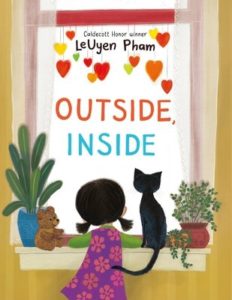
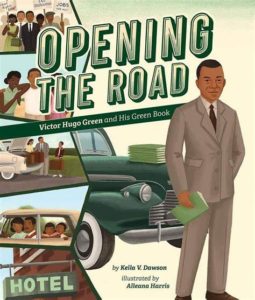
 Edna Cabcabin Moran is an author/illustrator, poet, arts educator, and hula dancer. Having been raised in the continental
Edna Cabcabin Moran is an author/illustrator, poet, arts educator, and hula dancer. Having been raised in the continental 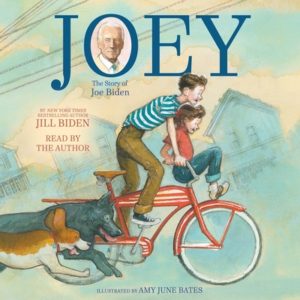
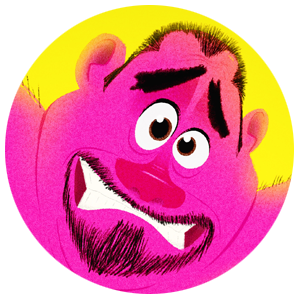


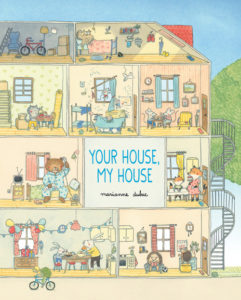
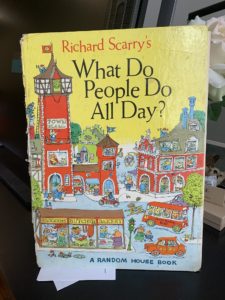 boxes from my recent move, to find my own tattered copy of Richard Scarry’s book.
boxes from my recent move, to find my own tattered copy of Richard Scarry’s book. Kelly Light lives in Amherst,
Kelly Light lives in Amherst, 